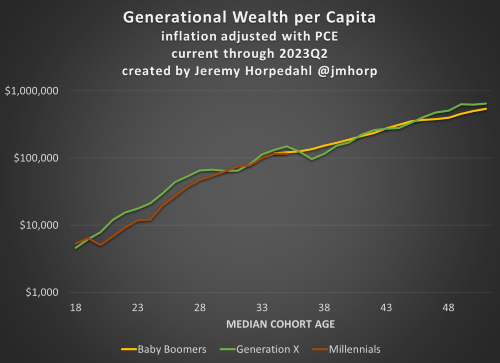Extras: Jeremy Horpedahl on The Real Cost of Thriving Index
September 28, 2023

We might disagree about how many goods and services are really necessary for a good life but we should be able to agree about what numbers to use to measure goods and services, shouldn't we?

We might disagree about how many goods and services are really necessary for a good life but we should be able to agree about what numbers to use to measure goods and services, shouldn't we?
There’s a question floating in the media miasma: Are we really better off now than in the recent past? Will Zoomers be the first generation worse off than their parents?
In this episode of The Great Antidote, host Juliette Sellgren welcomes economist Jeremy Horpedahl to discuss a paper he co-authored with Scott Winship. The paper is in response to the Cost of Thriving Index (COTI) developed by Oren Cass. In short, Horpedahl and Winship argue Cass’s index gets it wrong.
Cass developed his index by comparing what the median male worker spends on five types of goods- food, housing, health care, transportation, and education- today versus in 1985.
Cass’ claim: Today, it takes the median male worker 62 weeks to afford one year’s worth of these goods. In 1985, it only took him 40 weeks. That is, today, a year’s worth of needs takes more than a year to earn. If true, we should all be a little worried and the Zoomers should be really worried. Let’s dig in…
1- What is the cost of thriving, and how does thriving compare to the traditional use of cost of living in this context? Cass suggests focusing on food, housing, health care, transportation, and education. Are there other components you would include?
2- Sellgren asks Horpedahl why economists are so obsessed with indices. What are the advantages and disadvantages of using indices to consistently measure over time, according to Horpedahl? Since GDP per capita is roughly 20 times higher than in 1790 (and almost doubled since 1985), how can it be that Americans aren’t thriving? What do indicies help us understand and what might they hide?
3- For what reasons does Horpedahl argue Cass’s COTI does not give an accurate picture of economic well-being? He discusses shortcomings in Cass’s measurements in each of the five categories measured; which seem most extreme to you, and why?
As luck would have it, Horpedhal posted the graphic below on X (formerly Twitter) on September 22. How does the share of income measure compare to the hours worked measure? (Remember, Cass’ COTI is focused on 1985 and beyond so watch your x-axis.)

4- Sellgren naturally asks Horpedahl what needs to happen to make the cost of thriving decrease? One reason for COTIs starkness is that some lower-quality goods can’t be substituted today. If all new houses have more square footage or all minivans have extra features, you have to buy the houses and minivans that exist. Both Sellgren and Horpedahl agree they do not want worse quality goods. So what else could decrease the cost of thriving? Which of Horpedahl’s proposals seem most promising to you, and why?
5- As a young woman soon to be on the job market, Sellgren tells Horpedahl she’s baffled by the obsession with male workers in indices like the COTI. What does she mean by this? What does Horpedahl tell her she’s right to worry about? What does he suggest she might worry less about? What do YOU think is the right thing to worry about in this context?
P.S. Call your parents. Jeremy is right.